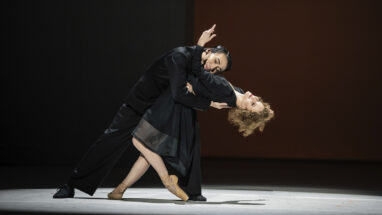
Thomas Mann and the anatomy of longing
Death in Venice, which will be seen at the Finnish National Ballet in November 2024, is based on Thomas Mann’s novella of the same name. Mann, who received the Nobel Prize in literature in 1929, is best known for his fiction, which includes eleven novels and about thirty novellas. In this article, Jukka O. Miettinen writes about the author’s life, work, and its significance.
Death in Venice is a ballet based on the 1912 novella of the same name by the German writer Thomas Mann. Mann is regarded as one of the literary giants of the early 20th century, with a remarkably diverse career spanning more than half a century. During this time, he wrote poems, plays, articles, essays, and over 600 lectures, though he is best known today for his narrative fiction. His body of work includes eleven novels and around thirty novellas, with Death in Venice being the most famous. Mann was awarded the Nobel Prize in Literature in 1929.
Thomas Mann was born in 1875 into a distinguished bourgeois family in Lübeck. In 1905, he married Katia Pringsheim, the daughter of a wealthy and cultured secular Jewish family. The couple had six children. In Germany, the family is sometimes referred to as the Mann literary dynasty, which also includes Thomas’s elder brother, Heinrich, who achieved literary fame first. The brothers were close, though their opposing political views caused long-standing friction. While Heinrich supported social democracy, Thomas was initially a steadfast patriot who backed the imperial regime. The family was tightly knit. Katia and the children often served as the first audience for Mann’s writing, as he read them excerpts from his works-in-progress.
From early in life, Thomas Mann was drawn to young men his own age. This is evident in his correspondence and diaries. In his 1903 novella Tonio Kröger, a young aspiring artist awakens to his homoeroticism and describes feeling like ”a marked man, mysteriously different from other people.” Artistic expression and sexual otherness remained central themes throughout Mann’s work.
The Manns amidst turmoil
Mann’s second novel, The Magic Mountain, was published in 1924. Its international success was followed by the Nobel Prize five years later, taking Mann to the height of his fame. The post-World War I period of the Weimar Republic, up until 1933, was relatively liberal. The Manns’ two eldest children, Erika and Klaus, for instance, were able to run a bold political cabaret and live relatively openly as homosexuals. However, society was in flux, and Thomas Mann was now leaning heavily to the political left.
Munich, where the Manns lived, was the stronghold of the National Socialist movement. As tensions escalated, the Mann children urged their parents to emigrate to Switzerland. They moved there in 1933, when the Nazis began persecuting Jews and homosexuals and burning books. Mann’s works were not sent to the bonfires. His sensitive diaries, however, were left behind at their Munich home. Should they have fallen into Nazi hands, they would have destroyed his reputation. After many complications, they were eventually brought to Switzerland.
In 1943, Katia and Thomas moved to the United States, where Mann taught at Princeton University and became a central figure in the émigré community. He began a series of radio broadcasts, distributed internationally by the BBC, which criticised Hitler and attracted significant attention. Mann’s major novel Doctor Faustus was published in 1947. It is a pessimistic portrayal of the decline of humanistic values during World War II, with a protagonist who makes a pact with the devil. In 1953, the Manns returned to Switzerland, where Thomas Mann died in 1955. His diaries remained sealed for two decades.

Death in Venice and its many interpretations
The novella Death in Venice, which Thomas Mann wrote at the age of 36, gained widespread popularity as soon as it was published. The story is rich with layers of meaning. As usual, Mann offers a highly precise and nuanced depiction of the world surrounding his protagonist. In his cholera-induced delirium, Aschenbach’s grasp of reality begins to fade, and various human figures take on supernatural meanings. In his mind, Aschenbach associates Tadzio with the idealised youth of antiquity, such as Ganymede, Narcissus, and Eros. The story can also be interpreted as a symbolic and mythical yearning for beauty and light.
In his signature style, Thomas Mann drew from his own experiences and personal encounters as material for the story. For instance, Mann did holiday at the Lido with his wife and son. In her 1975 memoir, Katia wrote that all the details in Death in Venice were based on real events, except for Thomas following the boy around Venice. The more or less latent homosexuality of the husband and father was no secret within the family.
Death in Venice has inspired several artists to create their own interpretations of the story. The magnificent 1971 film by Italian director Luchino Visconti is heavily coloured by Gustav Mahler’s symphonic music. Mahler was a family friend of the Manns, and the music reflects the spirit of the time. In 1973, Benjamin Britten adapted the novella into an opera, which became his final work. The role of Aschenbach was performed in the premiere by his life partner, tenor Peter Pears. The novella was adapted into a musical in 2019 by Belgian director Ivo van Hove. In Finland, Sanna Kekäläinen created a choreography of the story in 1999, with Jorma Uotinen in the lead role. Most recently, Carl Knif brought it to life through dance theatre at Oulu City Theatre in 2023.
Text JUKKA O. MIETTINEN
The writer is a dance critic and non-fiction author with a doctorate in dance arts.
Photos ROOSA OKSAHARJU
Death in Venice at the Finnish National Ballet from 1 to 23 November 2024.
Recommended for you

Javier Torres's new, stronger Giselle

Giselle’s costumes inspired by old Italian photographs

Édith Piaf – La vie en rose: Behind the Scenes with the Creative Team

Behind the scenes: Blushing

Death in Venice: insights from the choreographer and dancers

A beginner’s guide to ballet

”The love that dare not speak its name”

